In today's society, why do some diabetics saw off their feet? Is there really nothing that can be done if you don't saw off your feet?
In today's society, why do some diabetics saw off their feet? Is there really nothing that can be done if you don't saw off your feet?
One common complication of diabetes is rotting feet, a common practice nowadays is the cutoff, which aims to stop further ulceration, but is often ineffective.
Diabetic patients can not reasonably metabolize sugar, the use of sugar, began to be powerless, people, no matter how inactive, but also consume energy, no sugar, can only be replaced by protein in the body, the longer the protein is getting less and less, the person slowly become thin. The human body is injured, the healing time also depends mainly on protein, the drug is to prevent inflammation, no protein will not heal, can only use the cut-off method to stop and slow down the speed of ulceration.
If sugar can be was still stuck in the control of diet, exercise to lower sugar level, rotten feet, blindness, kidney failure and other complications will be difficult to prevent, to solve the contradiction between the blood sugar more and the cells have no sugar, in order to prevent complications.
First time answering a question in a headline ~ I'm a medical student, so let me answer this one.
First of all, it should be clear that those diabetics who saw off their legs did not do so because they were diagnosed with diabetes, but rather, they had diabetes for many years and now have diabetic complications - diabetic foot - and had no choice but to saw off their legs.
Secondly, what is diabetic foot? It refers to a pathological state of diabetic patient's foot or lower limb tissue destruction, such as ulcers, bone and joint lesions and even gangrene caused, which is often the result of lower limb vascular lesions, neuropathy and infection. Early symptoms manifested as cold feet, numbness, discomfort in the lower limbs after exercise, symptoms are alleviated after a short rest; in the middle stage, the pain in the lower limbs, especially at night, the pain is heavier, in addition to pain in the lower limbs in the late stage, it will be accompanied by localized ulcers, gangrene. The car is sacrificed to protect the king, that's why the leg has to be sawed. Current medicine, regardless of Chinese and Western medicine, there is no better way than this.
People with diabetes have no choice but to saw off their legs because they have a serious complication of diabetes called "diabetic foot".
What is a diabetic foot? Is sawing off the leg the only treatment when you have diabetic foot disease? What can be done instead to prevent and aggressively treat it? Learn about diabetes first.
Diabetes mellitus is a hyperglycemia caused by impaired insulin secretion and various degrees of peripheral insulin resistance. Early symptoms of diabetes are associated with hyperglycemia and include excessive thirst and drinking, excessive urination, and excessive eating. The main concern about diabetes is its complications.
Complications of diabetes mellitus, including vasculopathy, peripheral neuropathy and good infections due to impaired immune function. Chronic poor glycemic control is a key factor in the development of complications of diabetes.
Diabetic microangiopathy is the basis for three of the most common and damaging complications of diabetes. These three most common complications are: diabetic retinopathy, which can lead to vision changes and even blindness; diabetic nephropathy, which can lead to uremia; and diabetic neuropathy.
Diabetic microangiopathy, which can significantly slow down the healing of wounds, can sometimes develop into ulcers even for very small wounds, and can become easily infected and persistent.
Diabetic microangiopathy can in turn cause diabetic neuropathy, mainly because of the pathogenesis that can lead to nerve ischemia, the direct action of hyperglycemia on neurons, and intracellular metabolic abnormalities that impair nerve function.
Impairment of neurologic function can manifest as a symmetrical polyneuropathy, and on examination it is possible to detect sensory deficits and decreased ankle reflexes. Patients with loss of tactile sensation are at the greatest risk of developing foot ulcers. Therefore, many patients who develop diabetic foot are not able to detect it in time at first, and by the time it is detected, diabetic foot disease may have already occurred.
For diabetic foot prevention, foot examinations should be performed at least once a year to detect any characteristic signs of peripheral neuropathy such as decreased pressure, vibration, pain or temperature sensation.
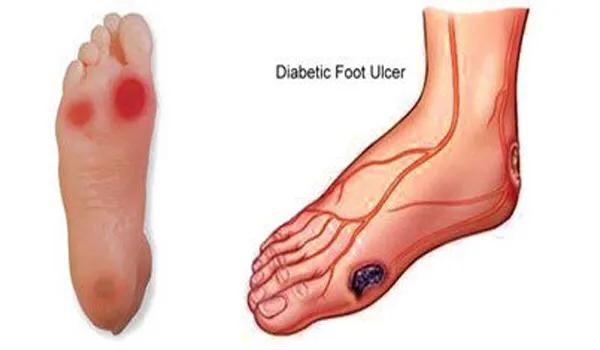
The best way to check for pressure sensation is to use a monofilament tactile measuring device, which should be used to examine the entire foot, especially the skin just below the metatarsal heads, for signs of rupture and ischemia, such as ulcers, gangrene, fungal infections of the toenails, diminished pulsation and loss of body hair.
Tight glycemic control reduces neuropathy. Treatments for symptomatic relief include topical application of capsicum cream, administration of tricyclic antidepressants (e.g., promethazine), anticonvulsants (e.g., gabapentin and carbamazepine), duloxetine, and pulsatilla. Check your feet daily to detect minor foot injuries in a timely manner and prevent them from developing into body-harming infections.
wrap-up
Diabetic foot disease is one of the most serious and expensive chronic complications of diabetes to treat, and can lead to amputation in severe cases. The relative risk of lower limb amputation in diabetic patients is 40 times higher than in non-diabetic patients. The etiology of non-traumatic amputations in our tertiary care hospitals is due to diabetes mellitus in 1/3 of the patients. About 85% of amputations are caused by foot ulcers, and about 15% of diabetics will develop foot ulcers in their lifetime, so the situation is very serious.
The pathogenesis of the diabetic foot is comprehensive and involves neuropathy, vasculopathy and infection. The combination of these factors can lead to ulceration and gangrene of the tissues.
Diabetics lose the self-protection of the foot when sensory loss occurs and are susceptible to injury, and this is a time when special attention should be paid.
The diagnosis and treatment of the diabetic foot involves many specialties. Some places have specialties for diabetic foot disease, but if such specialties are not available, the endocrinologist should have to discuss the next step in further diagnosis and treatment with doctors from related specialties such as vascular surgery, orthopaedics, trauma surgery, and infectious diseases.

I am a clinician who loves science, seeing patients, consulting, answering questions, solving puzzles, popularizing medical knowledge, and experiencing the power of warm words in the midst of my hurried clinical work!
Feel free to like, comment, retweet and favorite this article if it was useful to you. For more medical knowledge, stay tuned to Dr. Long!
It's really a sad question.
Why would a diabetic want to base off their feet? How they wish they could keep their feet, and for those times when they have to part with their feet, there must be something more important to keep than their feet, and that is their life.
What a diabetic foot feels like
When a person with diabetes develops foot lesions, it is called "diabetic foot". This is a condition that many people with diabetes fear, and it is also the last thing healthcare professionals want to see or deal with.
The diabetic foot is caused by persistent high blood sugar leading to lesions of blood vessels and nerves, which can feel pain, numbness, and abnormal sensations such as heat, cold, or ants and cotton tread.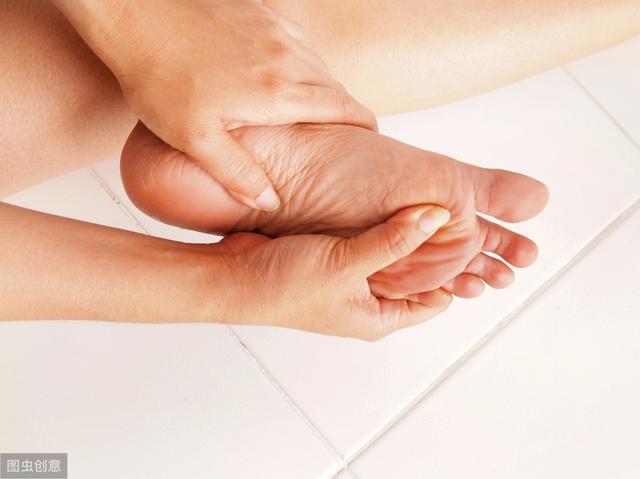
If there is a wound or ulcer, it is very easy to develop infection and gangrene, most of the wound area is infected with mixed bacteria, it will emit a rotten corpse-like smell, very stinky, very unpleasant, need to change the medicine every day to remove the necrotic tissues, and the wound is very difficult to heal, the newborn granulation tissue is very little and unhealthy, and for the gangrene is serious, such as arterial-vein obstruction, then there is no more healing of the necrotic tissue In severe cases of gangrene, such as arterio-venous obstruction, there is no possibility of healing the necrotic tissue, and the limb has to be amputated, which is the so-called "amputation of the limb to save the life" that doctors often communicate with patients.
The diabetic foot is a very common complication in people with diabetes and a major cause of death and disability in diabetes.
Diabetic foot treatment is a challenge
The diabetic foot is an acute lesion on top of the chronic complications of diabetes that needs to be treated as soon as possible, but because of the presence of neurological and vascular lesions, the treatment will take longer, be less effective, and cost more.
Serious infection of the foot if the patient is also combined with severe ischemia, vascular obstruction, then the treatment will be very poor, the infection is difficult to control, and will gradually spread upward, leading to bacteremia, infectious shock, etc., may be life-threatening, in this case, it is necessary to amputate as soon as possible surgical treatment, and usually this amputation is high amputation.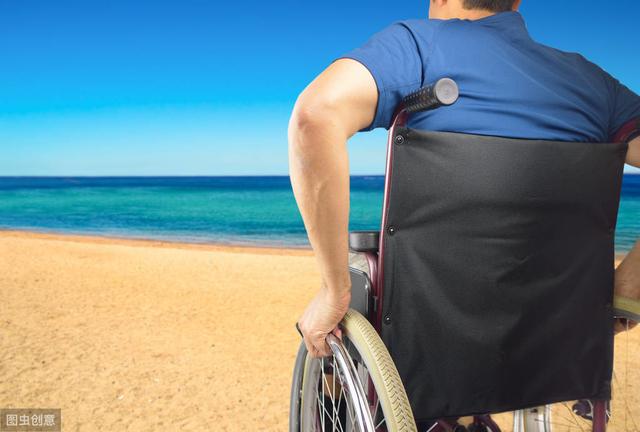
This is the reason we often communicate to patients in the clinic that foot lesions require amputation from the knee up. Many patients do not understand, think, I am just the bottom of the foot pus, toes rot a few, why should I amputate my leg all the reasons. Because the lower extremity arterial vascular occlusion, nutrition and blood transport can not reach the patient site, low amputation wounds will not heal, it is necessary to go up, choose the blood flow is relatively good, in order to ensure that the surgical effect.
So for a diabetic friend who is adequately assessed and deemed to need amputation, then the above possibilities may exist, which is a tough choice for the patient, family and doctor, but amputation to save a life is a simple and brutal truth. Therefore not having a diabetic foot is the best thing to do.
How to tell if you have a diabetic foot
The first thing to do is to determine if you have diabetic feet, and if you have one of the following conditions, you should go to the hospital as soon as possible for examination and treatment.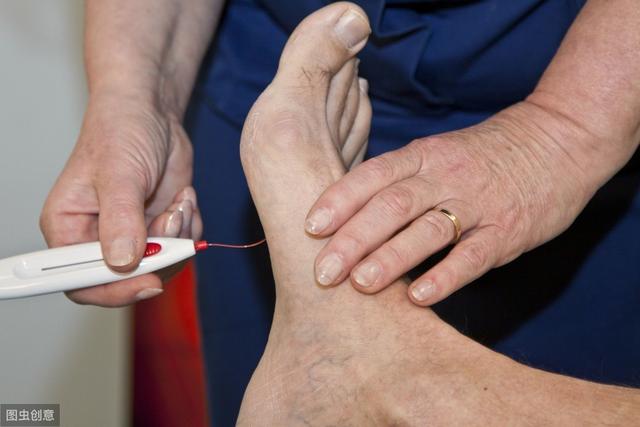
Numbness and pain in the lower extremities, dulled sensation
When the feet hang down, the skin color of the lower extremities gradually turns purple
Decreased or absent vascular pulsations in the dorsum of the foot
Intermittent claudication occurs during walking
Muscle atrophy or foot deformities in the lower limbs.
Diabetic feet are scary, how to keep them from appearing
For diabetics, it is vital to keep their blood sugar steady. Normal blood sugar is the basis for preventing various complications.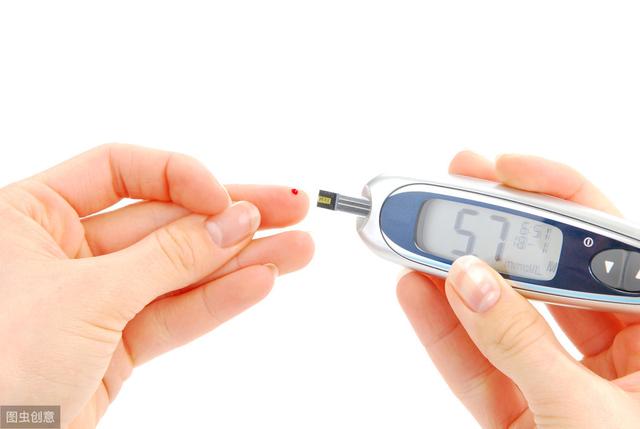
Usual foot protection is also very important, how to protect their feet in daily life, then do the following points are very critical:
tobacco cessation
Cigarettes damage blood vessels, which can affect their ability to deliver oxygen, and long-term smoking increases the risk of amputation. People with diabetes must quit smoking.
Do not walk barefoot at any time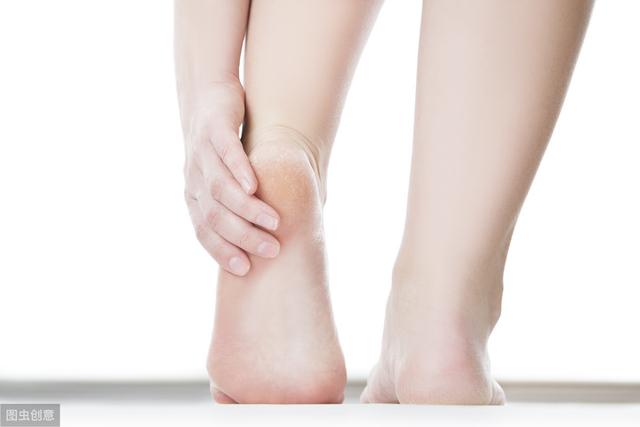
The peripheral nerves of diabetics will be affected to a certain extent, and the sensation of the feet will be less sensitive, and the perception of foreign objects will be poorer, so it will be easy to cause skin damage without realizing it, and thus diabetic feet will appear. New shoes or unsuitable socks may also have an effect.
Ensure that your feet are clean
Clean your feet daily with lukewarm water, using a thermometer or having a family member help prepare a foot wash to prevent burns that may result from water that is too hot. Dry gently with a soft towel, including between the toes. Use lotion to keep skin soft and prevent dryness to reduce the risk of skin breakdown. Trim your toenails regularly to prevent them from becoming too short and damaging the skin around them.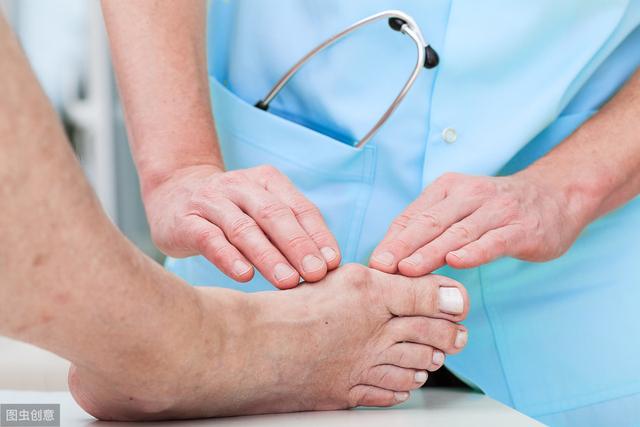
Keep your feet warm
Wear soft cotton socks to bed, try not to let your feet get wet from rain or snow, wear warm shoes and socks in winter to prevent frostbite, and try not to use hot water bags, kettles and electric blankets to keep warm, or put your feet in front of electric heaters and stoves to avoid scalds and burns caused by dulled senses.
Prevention is very important, as is early treatment as soon as possible.
Prevention is very important, early treatment as soon as possible is also very important, the most critical is that diabetic friends should have a correct understanding of their own condition and judgment, in the emergence of foot lesions should be as early as possible to consult the doctor, to prevent procrastination, look at the mentality of the problem may be a small problem to drag a big, serious, and even fatal serious consequences.
To summarize:
Diabetic friends should be based on diet, exercise, and actively cooperate with medication to keep blood sugar stable and prevent diabetic peripheral vascular and peripheral nerve lesions. Nerve and blood vessel lesions should be treated with medication to slow down the progress of the lesions. Pay attention to the protection of the feet, check the integrity of the skin of the feet every day, if there are symptoms such as redness, swelling and pain, go to the hospital as soon as possible, do not treat yourself. After the doctor carries out the evaluation of blood sugar, nerve, blood vessel, infection and other related items, if amputation treatment is recommended, it is recommended to accept the doctor's advice, otherwise it may be life threatening.
I'm Dr. Sun, pay attention to Dr. Sun talk about sugar, continue to learn more quality health knowledge, help please like, have questions please leave a message, will reply!
At present, the number of diabetic patients in China is relatively large, according to the statistics of authoritative departments, every 10 people are diabetic patients, so that there are more than 100 million patients in China. In recent years the number of diagnosed diabetics has increased to a certain extent, and there are many young people who have this chronic disease, which has become one of the main threats to human health. I would like to share my knowledge about diabetes in order to help you to prevent and treat the disease.
1. Why does the diabetic foot occur?
Although we are not strangers to diabetes, but not many non-medical people really understand it, many patients with diabetes after the lack of awareness of the dangers of it, that is simply elevated blood sugar, so see high blood sugar to take some hypoglycemic drugs, blood sugar is normal, do not take medication. And for diabetic patients to control the diet is more important, one or two days may be able to tolerate, after a long time will not be able to control, and began to eat and drink, as if they have never had diabetes, which will make the blood glucose control is relatively poor.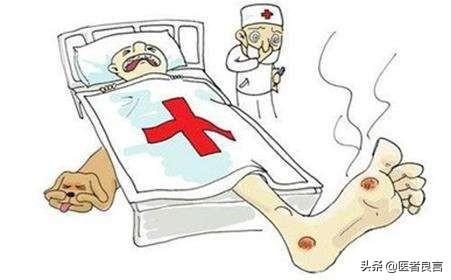
If the blood sugar control is not good, it will accelerate the destruction of blood vessels, we have to understand that blood vessels are equivalent to the pipeline to transport nutrients, if the blood vessels are not good, then it will cause a reduction in the blood supply to the feet, in the early stage, the feet can still compensate for the blood supply is a little bit less, but the severity of a certain degree, the feet began to appear the pain, ulceration, or even necrosis, which led to the formation of diabetic foot.
2. Does the diabetic foot have to be amputated? What are the consequences of not amputating?
In fact, the diagnosis of diabetic foot does not necessarily mean that a cutoff is needed, and the exact language of the treatment depends on the stage of the diabetic foot.
Diabetic foot 1 phase mainly manifested as lower limb cold, numbness, cramps; 2 phase of the main symptoms of intermittent claudication, that is to say, walking a journey after the foot pain, rest for a while the pain relief, with the aggravation of the patient's condition the number of times of pain will increase significantly; 3 phase of the main manifestations of resting pain, that is to say, even if the activity will also be a foot pain; 4 phase of the main symptom of ischemia and necrosis of the foot, and even foot blackening, to phase 4 patients will need amputation. The main symptom of stage 4 is ischemic necrosis of the foot, and even the foot is blackened, and the patient will need to amputate the limb in stage 4.
For diabetic foot in the first 3 stages of patients can not need amputation, this time is possible to avoid amputation through strict control of blood glucose, clean and change medication and other measures.
There may be many patients who are unwilling to accept the reality of diabetic amputation, so they refuse to amputate, but if it really comes to a serious time is necessary to amputate. Diabetic foot ischemic necrosis, the treatment effect is relatively poor, if it is the kind of complete necrosis, or not amputation that will cause serious infection of the foot, bacteria produce toxins will enter the body, resulting in infectious shock and multiple organ failure, it is easy to induce death.
3. How to prevent diabetic foot?
In fact, the most fundamental measure to prevent diabetic foot is to control blood glucose, after being diagnosed with diabetes, take medication on time, control diet, insist on exercise, go to the hospital for regular checkups and actively learn about diabetes.
Early detection of diabetic foot is more meaningful than treatment, so it is more important to go to the hospital for regular examination. As a patient, you should check your feet every day to see if there is any trauma or damage, and if you find any damage, you must deal with it actively, otherwise it may cause ischemia and necrosis of the foot, which may lead to amputation.
Purely hand-typed, it is not easy, if you feel that the writing can also be rewarded a praise, point a concern, if you have any questions can be left below ......
The horror of diabetes is indeed chilling. I was surrounded by a mother and three sons, all diabetics, and then the mother died of diabetic foot, the eldest son died because he did not eat in time after taking insulin, and the second son is now in a state of almost blindness in both eyes.
As we all know, diabetes runs in families, and this mother was one of them. She was young when life is more favorable, and then the eldest son's business is doing great, so in the material more affluent, every day eat basically can not leave the big fish and meat, and finally not only the body is obese but also diabetes has found the mother and son of three.

The oldest son was the first to die. He because of business every day a lot of socializing, after the examination of diabetes, they are still more attention to control, but over time found that as long as the injection of insulin, and then eating and drinking does not have a great impact on the body, so slowly the heart of their own disease has also become slack.
It was more than ten years ago when he had his accident. That day he did not go out to socialize, but drove home at five o'clock in the evening, and when he arrived downstairs, he thought that he would have to eat dinner upstairs, so he injected insulin first. At that time there were a few old people were playing chess downstairs, he idly went to watch the fun, and as a result, he lost track of time, and by the time he felt unwell, it was too late, and he collapsed directly onto the floor!
When the ambulance arrived later, he had no vital signs!
This incident on his mother stimulation is very big, the spirit almost collapsed, until after nearly ten years, the mood slowly calmed down. However, this old lady, also belongs to the people who can not control the mouth, coupled with the body obesity and can not take a step, so the disease gradually develops. In 2014, she did housework accidentally touched the left foot, the wound delayed healing, and finally gradually have a tendency to ulcer.
The second son to send her to the hospital, she began to refuse to agree, but also listened to the words of an unreliable neighbor, I do not know from the above place to buy the ointment is said to be very effective, the results of the use of this ointment, the wound not only did not get better, but festering even more serious. The second son realized that the situation was not right and sent her to the hospital when her left foot already had a blackened condition.

The doctors tried their best to cure her, but the ulceration and blackening were uncontrollable, and eventually the center of the foot and the back of the foot rotted through, and the nurses had to use utensils to remove the rotting flesh every day. At that time I went to the hospital to see her, and her whole left calf and foot, were bruised and blackened.
This would certainly be fatal, so the second son asked the doctor if he could amputate the limb before the situation worsened. The doctor was in a dilemma: amputation would make it difficult for the wound to heal and would be equally dangerous. While the doctor and the family were struggling, her condition suddenly deteriorated, her organs failed, and she passed away!
Some time ago, I saw my second son, who has been attacked by diabetes and now can barely see out of both eyes!
What happened to this family of three was heartbreaking, and people said that if they had taken the disease seriously after discovering it, strictly followed the doctor's instructions, controlled their appetite and exercised more, what happened later might not have happened!
Like please follow, the image source network infringement joint deletion!
Generally speaking, there is almost no way to completely reverse the chronic complications of diabetes caused by long-term diabetes, and diabetic foot wounds don't heal because diabetes leads to macrovascular and microvascular complications. Wound healing requires fresh blood, but after the vascular complications, the blood can not reach the wound, and there is no way to fight bacteria, only to get worse and worse. Keeping the necrotic tissue at this time will only lead to more serious complications, so the only option is to excise it, and sometimes even a part of the tissue that seems to be alive has to be cut off because the circulation is so poor, or the wound won't heal, which is even more troublesome!
Foot massage can help with diabetes recovery. It can be effective in stopping saw feet.
One serious complication of diabetes is the "diabetic foot". The foot is the root of the human body, and it is also the place where the terminal nerves and tiny blood vessels gather. Diabetes is the first to affect the small nerves, small blood vessels, resulting in terminal nerves, microvascular lesions, which leads to abnormal nerve sensation in the feet, blood supply is impaired, and over time the feet of diabetic patients have become a piece of "very easy to spoil the cake".
The feet themselves are often in a moist, airless environment, compared to the hands, more susceptible to fungal and bacterial infections. The feet of diabetic patients are like a piece of "highly perishable cake", long-term in the fungi and bacteria in the invasion, very easy to occur fungal and bacterial infections lead to feet red, swollen, ulceration, necrosis, serious can be complicated by systemic infection and crisis of life.
The diabetic foot is usually necrotic and deeply infected, and it is likely that the option of "sawing the foot to save its life" is a last resort.
Diabetic foot infection does not always mean "sawing the foot to save the life", most of the patients through the doctor's early, careful, patient medication adjustment may be able to save the foot.

Dr. Zhao experienced treating such a patient with diabetic foot as a student:
An old grandfather more than 70 years old, diabetes, high uric acid gout for decades. The old man adhering to the old generation of hard work and endurance of the spirit of the disease - diabetes does not hurt, gout is only an occasional pain to endure a past, neither medicine nor dietary control, fingers and toes to grow a number of gout stones have not been dealt with. Until the ankle joint below the growth of a large stone can not wear shoes, the old man to the local rural hospital for gout stone removal surgery, dug out the stone. After the stone digging out of this pit a long bad, but also does not hurt, can wear shoes, the old man also do not care about it.
A few months later, the old man's family always smelled a foul odor beside the old man, and after rummaging through his body, the stench was most pronounced in this pit(diabetic foot infection)It is at this point that the family feels that the condition is serious enough to come to the hospital for treatment.
The treatment involves first clearing the wound and then repeatedly changing the medication. Cleansing needs to scrape off the local tissue, normal people in the wound to scrape a little bit of meat will be painful wailing, the old man scraped the process of total painless!(Diabetic foot peripheral neuropathy)The medicine will be changed repeatedly until the new flesh grows out. After that, change the medication repeatedly until new flesh grows, and go home to condition and change the medication slowly.

Diabetes does not usually complicate the diabetic foot if your blood sugar is under good control;
Diabetic feet are also usually not infected if they are hygienic and breathable;
Infections are treated promptly, and "sawing off feet to save lives" is generally not an option.
Therefore, it is important to treat and control blood sugar when diabetes is detected to avoid or delay complications.
Follow Dr. Zhao for more health knowledge.
Speaking of diabetes, in fact, many people do not think, we often find that the first time to the outpatient clinic patients, often because of foot numbness to the neurological or surgical consultation, in fact, for patients with diabetes, this section is mostly the emergence of diabetic peripheral neuropathy.
This article was originally published by Stardust.
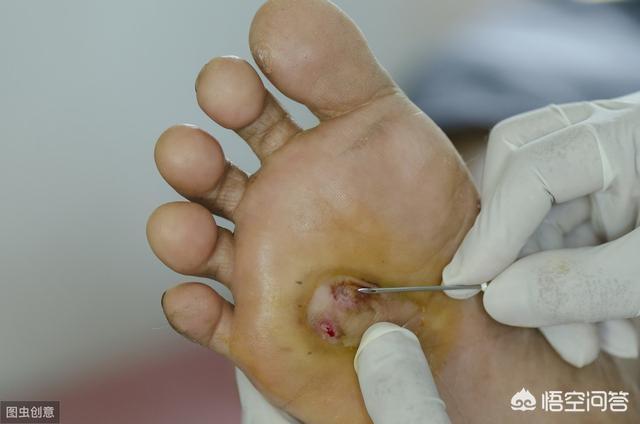
And like the title says, diabetics saw off their own feet, which is of course due to the presence of diabetic feet that have developed to such a serious degree as to cause gangrene that the condition cannot be controlled and can only be amputated.
So what is a diabetic foot?
Diabetic foot is mainly due to the diabetic patients appear distal foot peripheral vascular lesions as well as neuropathy, resulting in insufficient blood supply to the foot, neurosensory lesions, which is often prone to ulcers, infections, and if it can not be controlled, then tissue necrosis gangrene, leading to amputation.
The following schematic illustrates the onset and progression of the diabetic foot very clearly ↓↓↓↓
This article was originally published by Stardust.
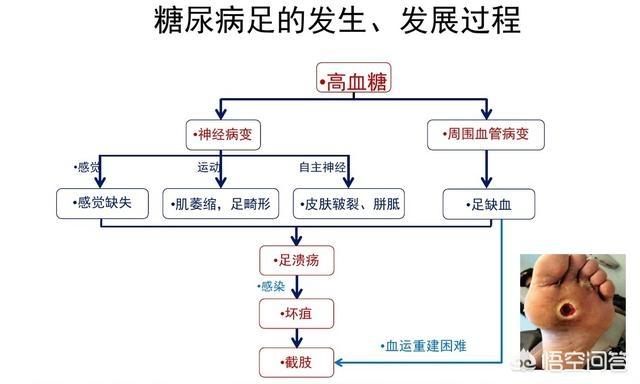
China is a large country with diabetes, according to statistics, in 2013 the prevalence of type 2 diabetes reached 10.4%, there are more than 100 million people with diabetes, many people usually do not pay attention to the symptoms of diabetes, there are many patients know that they have diabetes, but because of a variety of reasons, or mislistening to other people's rumors intentionally do not treat, and the result is that at the end of the day there are a variety of complications of diabetes.
Among diabetics over the age of 50, the chances of developing a diabetic foot are as high as 8.4%.
So in order to avoid amputation due to diabetic foot, we need to know how to avoid diabetic foot in the first place:
1, first of all, the most important point, but also the most should be emphasized is: must be controlled at a reasonable level of blood glucose, only to control the blood glucose, in order to avoid the occurrence of diabetic foot.
2. Patients with diabetes are usually comorbid with metabolic disorders and must control LDL to less than 1.8 mmol/L or a 50% reduction from the original lipid level.
3, combined with high blood pressure patients, should be controlled below 130/80mmHg, of course, should still be determined by the competent doctor according to the condition.
4, must must quit smoking, smoking will lead to vascular endothelial damage, resulting in vascular occlusion, especially harmful to diabetic patients.
5, patients with diabetes, especially patients who have diabetic peripheral neuropathy, we generally ask patients to regularly trim toenails, and usually choose soft and unbroken socks, choose moccasin shoes, cloth shoes and breathable casual sports shoes, so that you can maximize the avoidance of skin breakage, reduce the occurrence of diabetic foot.
This article was originally published by Stardust.

6, personal hygiene is very important, pay special attention to foot health, to wash your feet every day, but also pay attention to the temperature of the foot-washing water should not be too hot, because diabetic patients often have numbness in the lower limbs, sensory disorders, so we recommend that before washing the feet should be used to test the temperature of the water, so as to avoid scalding.
7, as we all know, the fall and winter seasons, feet easily dry cracked, and once the skin is dry and cracked it is easy to infection, for diabetic patients, especially so, available PH value of neutral moisturizer evenly coated in the surface of the feet, sweaty feet can be sprinkled with some talcum powder.
8, diabetic patients should go to the hospital regularly for screening, but also for evaluation of the condition, including blood sugar, glycated hemoglobin and blood lipids and other indicators.
This article was originally published by Stardust.

Again, prevention is most important if you want to avoid amputation.
Of course once a diabetic foot has already developed, what should be done to treat it?
Treatment needs to be controlled in the following main areas:
1, of course, is active and strict control of blood sugar, and maintain blood sugar stability.
2. Nerve repair: commonly used drugs include methylcobalamin.
3, anti-oxidative stress: commonly used drugs are lipoic acid.
4、Improve microcirculation: commonly used prostaglandin E1, cilostazol, ketocaine, calcium antagonists, blood circulation and blood stasis of traditional Chinese medicine and so on.
5, improve metabolic disorders: commonly used drugs aldose reductase inhibitors, such as epothilone.
6, if there is a skin ulcer, infection, even if it is a small break in the skin, must pay special attention to, as soon as possible treatment, if necessary, should be active anti-infective treatment, and combined with surgical dressing change, as soon as possible to bring the infection under control.
7、If there is lower limb arterial occlusion, minimally invasive interventional surgery can be considered according to the condition to open the blood vessels.
This article was originally published by Stardust.

Generally speaking, if you can get standardized, early treatment, most patients will not develop to the point of amputation, therefore, in fact, the attitude is very important, prevention is very important, only they pay attention to, in order to protect their own body, otherwise the disease once the development of a certain degree, then in the highly skilled doctors can not control.
This article is the "heart of the stardust" original, without authorization, please do not reprint, if you need to reprint, please leave a message to contact and obtain authorization! For more audio science popularization, please pay attention to the "heart road stardust"!
Dr. Stardust of the Heart: signed author of today's headline, monthly quality account of Qingyun program, deputy director of cardiology, member of Health Communication Committee of Chinese Physicians Association.
This question and answer are from the site users, does not represent the position of the site, such as infringement, please contact the administrator to delete.